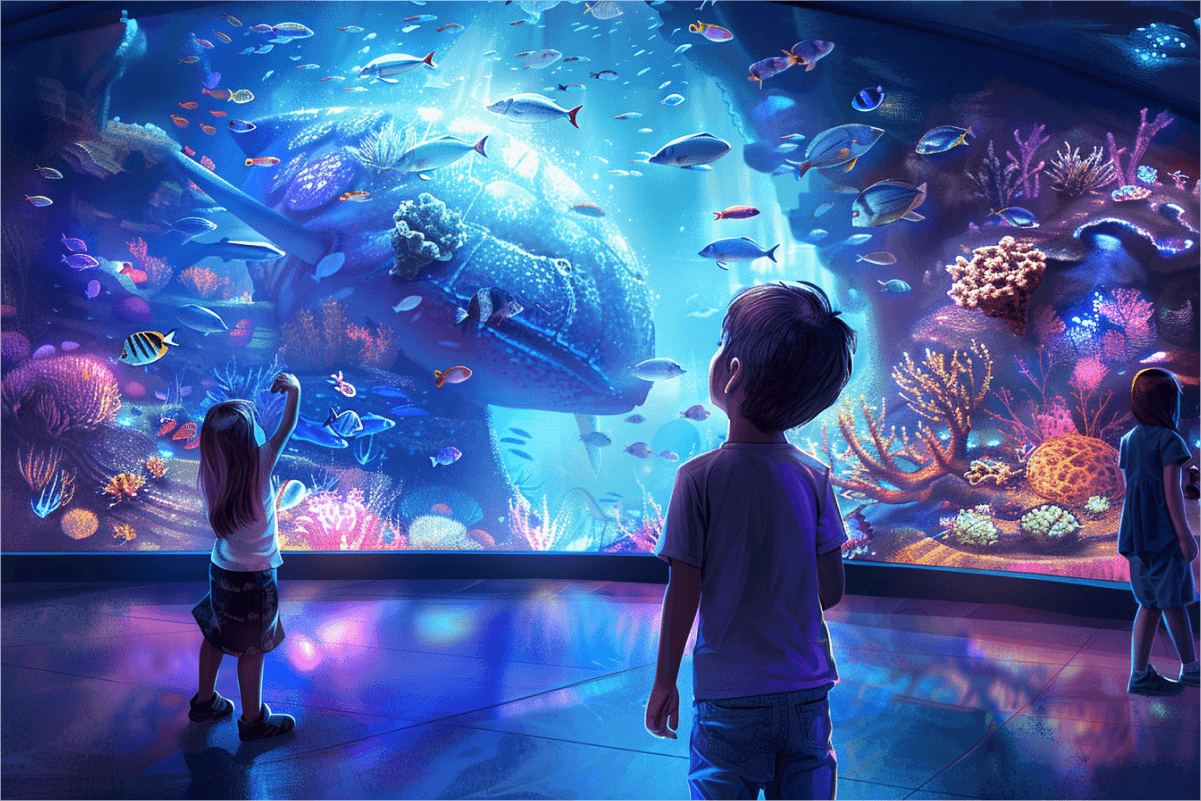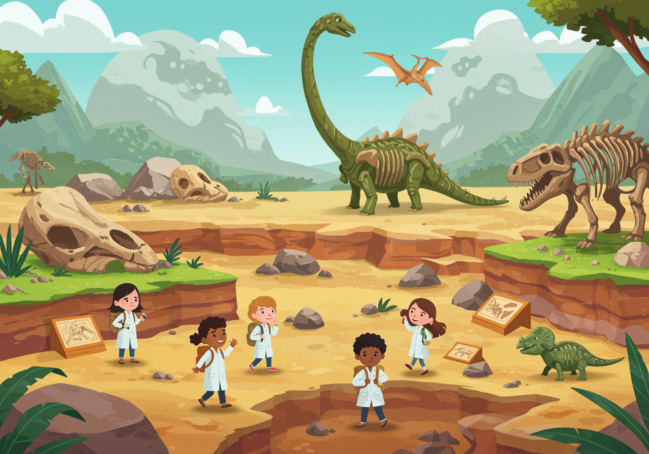Get ready to embark on an extraordinary adventure at the Phillip and Patricia Frost Museum of Science, where science comes to life! Nestled in the heart of Miami, this innovative museum offers an awe-inspiring mix of exhibits, planetarium shows, and an aquarium designed to ignite the curiosity of young minds. Expect to soar through the stars, dive into the depths of marine ecosystems, and unravel the mysteries of the universe in this unique and engaging environment. The Frost Science Museum is the perfect place for fun, learning, and endless exploration!
Interesting Facts About Phillip and Patricia Frost Museum of Science 🧠
- Once Upon a Time: The Frost Museum of Science first opened its doors in 2017 and has since welcomed millions of curious minds from around the world.
- Building It Up: The museum is designed to emulate natural forms and structures found in nature, such as the honeycomb shape of a bee’s nest!
- Water Wonders: The museum is home to a massive aquarium spanning three levels that recreates South Florida’s aquatic ecosystems.
- Cosmic Shows: Boasting one of the most impressive planetariums in the world, Frost Planetarium can seat up to 250 people and offers mind-blowing 3-D shows.
- Sustainability: Did you know the museum is designed to be environmentally friendly? It has solar panels and a rainwater collection system to reduce its ecological footprint.
Must-Visit Spots 📍
1. Gulf Stream Aquarium
- Interesting fact: The tank holds approximately 500,000 gallons of water, housing species like hammerhead sharks and manta rays.
Why It’s Cool: This three-story aquarium showcases marine life from the Gulf Stream, allowing you to see everything from the surface to the ocean floor.
Pro Tip: Stand beneath the oculus lens at the bottom level for a mesmerizing view of fish swimming above you.
Q1: What kind of fish or sea creature can you spot from the surface to the bottom of the aquarium?- Discussion Point: By observing the diverse marine life, you can see how different species adapt to various depths in the ocean.
- Supporting Fact: The Gulf Stream Aquarium’s three-story tank holds approximately 500,000 gallons of water. It houses species like the scalloped hammerhead shark, which detects prey using electroreception, a sense that allows sharks to sense electrical fields produced by living organisms. Hammerhead sharks often swim in schools during the day to protect themselves from larger predators.
- Discussion Point: This design helps you understand the vertical habitats and ecosystems within the ocean.
- Supporting Fact:The ocean has different zones such as the sunlight zone, twilight zone, and midnight zone, each home to specific types of marine life. For example, bioluminescent creatures thrive in the twilight zone, producing light through chemical reactions to attract prey or communicate.
2. Frost Planetarium
- Interesting fact: The planetarium’s dome is tilted at a 23.5-degree angle, the same as Earth’s axial tilt.
Why It’s Cool: Travel through the cosmos with shows that use state-of-the-art technology to create an immersive visual experience.
Pro Tip: Arrive a bit early to grab the best seats in the center of the planetarium for a full, encompassing view.
Q1: Which planets or constellations were highlighted in the show?- Discussion Point: Identifying celestial objects can spark an interest in astronomy and understanding our place in the universe.
- Supporting Fact: The Frost Planetarium uses a 16-million-color 8K projection system, one of the most advanced in the world. The Milky Way galaxy contains over 100 billion stars, and the planetarium can recreate phenomena such as stellar nurseries where new stars are born or supernova remnants from exploded stars.
- Discussion Point: Planetarium shows can simulate complex phenomena and provide a clearer view of celestial objects without atmospheric interference.
- Supporting Fact: The planetarium’s dome is tilted at a 23.5-degree angle, the same as Earth’s axial tilt, providing an authentic celestial experience. Using advanced projectors, it simulates the night sky, allowing detailed observation of distant galaxies, black holes, and neutron stars.
3. Feathers to the Stars Exhibition
- Interesting fact: The section on dinosaurs includes real fossils and a life-size cast of a T. rex skull!
Why It’s Cool: This exhibit traces the evolution of flight from the dinosaurs to modern-day space exploration.
Pro Tip: Look for interactive displays that let you ‘become’ a bird or fly a virtual spacecraft.
Q1: What are some ways humans have learned to fly by studying birds?- Discussion Point: The study of birds has led to innovations in aerodynamics and flight technology.
- Supporting Fact: Engineers studying birds of prey developed winglets on airplane wings, reducing drag and improving fuel efficiency. This biomimicry has revolutionized aviation, enabling planes to fly longer distances using less fuel.
- Discussion Point: Factors like fuel efficiency, life support systems, and thermal protection are crucial for space missions.
- Supporting Fact: Spacecraft require rigorous testing and advanced materials to withstand the extreme conditions of space. NASA uses materials like aerogel, one of the lightest known solids, to protect spacecraft from extreme temperatures.
4. MeLab
- Interesting fact: It has a feature where you can measure your grip strength and compare it to that of other animals, like chimpanzees.
Why It’s Cool: This interactive exhibit focuses on the human body and health, allowing you to explore how your physical and emotional self works.
Pro Tip: Try out the thermal camera to see the heat map of your body!
Q1: What did you learn about how your body reacts to different emotions?- Discussion Point: Understanding emotional responses helps in recognizing and managing feelings in healthy ways.
- Supporting Fact: Emotions trigger the release of various hormones. For example, cortisol is released during stress, affecting your heart rate and immune system, while endorphins released during exercise improve mood and reduce pain perception.
- Discussion Point: Seeing your heart rate rise during physical activity helps you understand cardiovascular health.
- Supporting Fact: Exercise strengthens the heart, making it more efficient at pumping blood throughout the body. The heart rate monitor can show how quickly your heart responds to physical exertion and how fast it recovers, indicating overall fitness levels.
5. River of Grass
- Interesting fact: The exhibit includes a section where soundscapes recreate the vibrant audio environment of the Everglades at different times of the day.
Why It’s Cool: This interactive exhibit mimics the Everglades ecosystem and is perfect for hands-on learning about Florida’s unique wetlands.
Pro Tip: Engage in the scavenger hunt feature within this exhibit to find hidden elements such as native animals and plant species.
Q1: What types of animals and plants did you find in the Everglades exhibit?- Discussion Point: The diverse species highlight the importance of the Everglades as a unique and vibrant ecosystem.
- Supporting Fact: The Everglades is home to an incredible array of wildlife, including the American alligator, a keystone species whose nesting habits create habitats for other creatures. The exhibit’s sawgrass plant has sharp edges that protect it from herbivores and helps it conserve water in the wetland environment.
- Discussion Point: Feeling the textures of plants can reveal adaptations that help them survive in wetland conditions.
- Supporting Fact: Everglades plants like the bald cypress have “knees” or root projections that help anchor them in the soft, waterlogged soil. These adaptations also facilitate oxygen intake in the low-oxygen environment of the wetlands.
Attraction Specific Scavenger Hunt Guide 🕵️
Ocean Explorer
- Objective: Find three different types of reef fish in the Gulf Stream Aquarium.
- Hint: Look for brightly colored fish near the artificial reef section.
Star Detective
- Objective: Identify two constellations shown in the planetarium.
- Hint: These patterns of stars often have names from mythology.
Dinosaur Tracker
- Objective: Locate the T. rex skull in the Feathers to the Stars exhibit.
- Hint: Look for an enormous head with sharp teeth!
Pulse Checker
- Objective: Measure your heart rate in three different activities at MeLab.
- Hint: Try activities like jumping, running in place, and resting.
Plant Whisperer
- Objective: Touch and identify three different plant textures in the River of Grass exhibit.
- Hint: Feel smooth, rough, and waxy leaves near the water plants.
Aquatic Artist
- Objective: Draw a picture of your favorite sea creature spotted at the aquarium.
- Hint: Use the colored pencils provided at the interactive art station.
Space Explorer
- Objective: Find the exhibit about the Mars Rover.
- Hint: Look for images and videos of red soil and robotic explorers.
Health Hero
- Objective: Record your top score on the grip strength test in MeLab.
- Hint: Strong grips often correlate with a healthy muscle system!
Wingspan Wonder
- Objective: Compare your wingspan to that of an eagle in the Feathers to the Stars exhibit.
- Hint: Find the interactive display with measuring tapes.
Wetland Wanderer
- Objective: Identify the call of a bird native to the Everglades.
- Hint: Listen for unique sounds at the audio stations in the exhibit.
Other Nearby Points of Interest 👈
Before you leave, make sure to check out more of what Miami has to offer! Here are a few nearby spots that we think you’ll love just as much as the Frost Museum of Science:
- Miami Seaquarium: This marine park offers exciting shows and interactions with dolphins, sea lions, and even orcas. It’s perfect for marine life enthusiasts!
- Vizcaya Museum and Gardens: Explore this historic estate with its beautifully preserved mansion and lush gardens. It’s like stepping back in time to the Gilded Age!
- Perez Art Museum Miami (PAMM): Located close by, this contemporary art museum features fascinating exhibits and can inspire creativity in both kids and adults.
Happy exploring, and keep the spirit of adventure alive! 🌟🦜
You might be interested:



